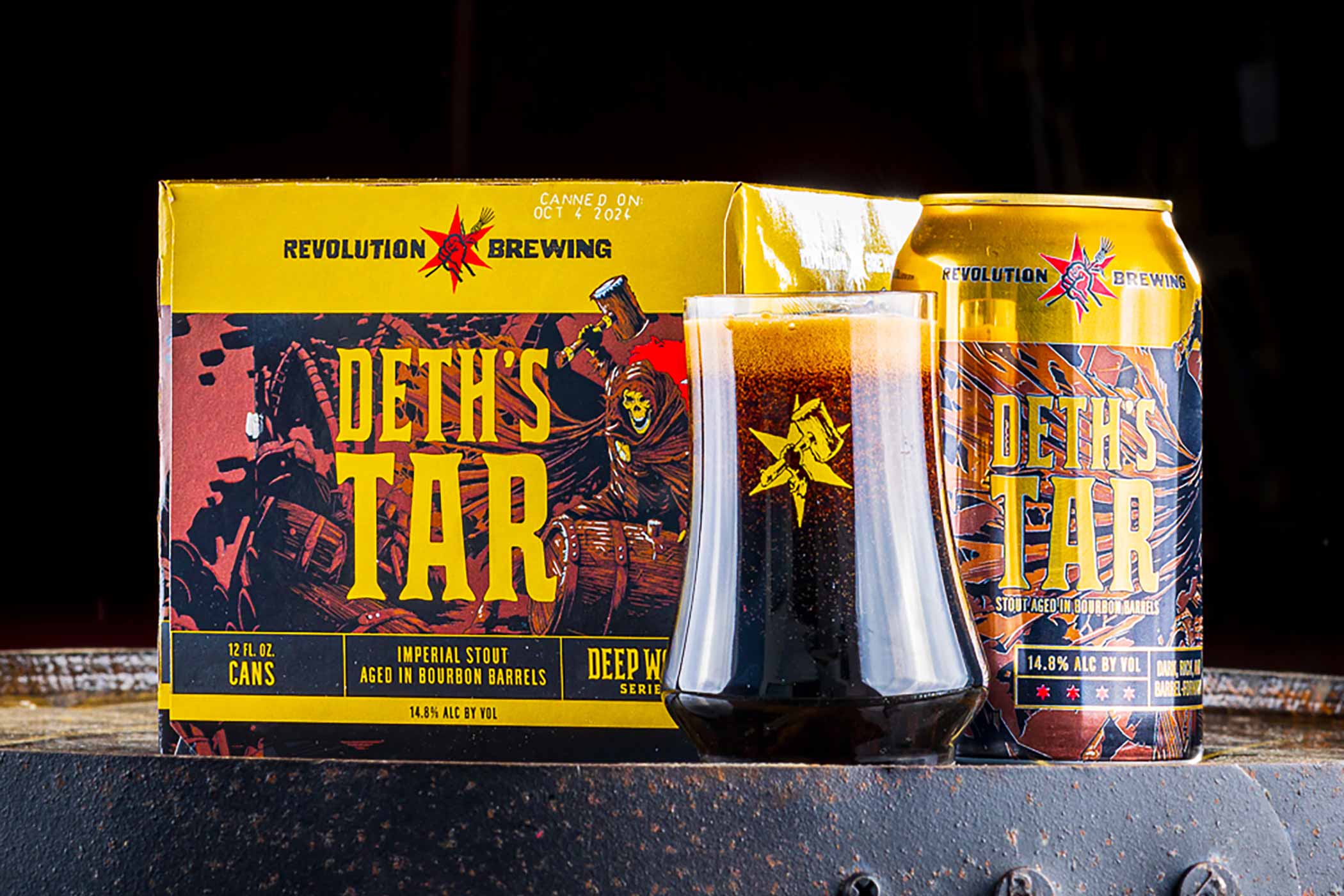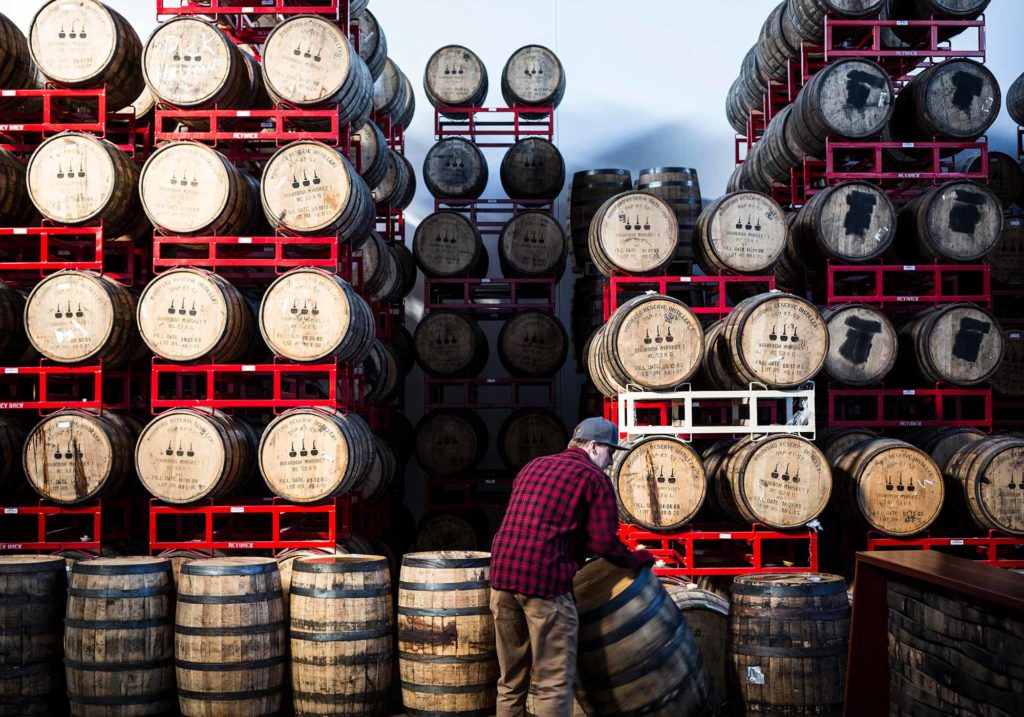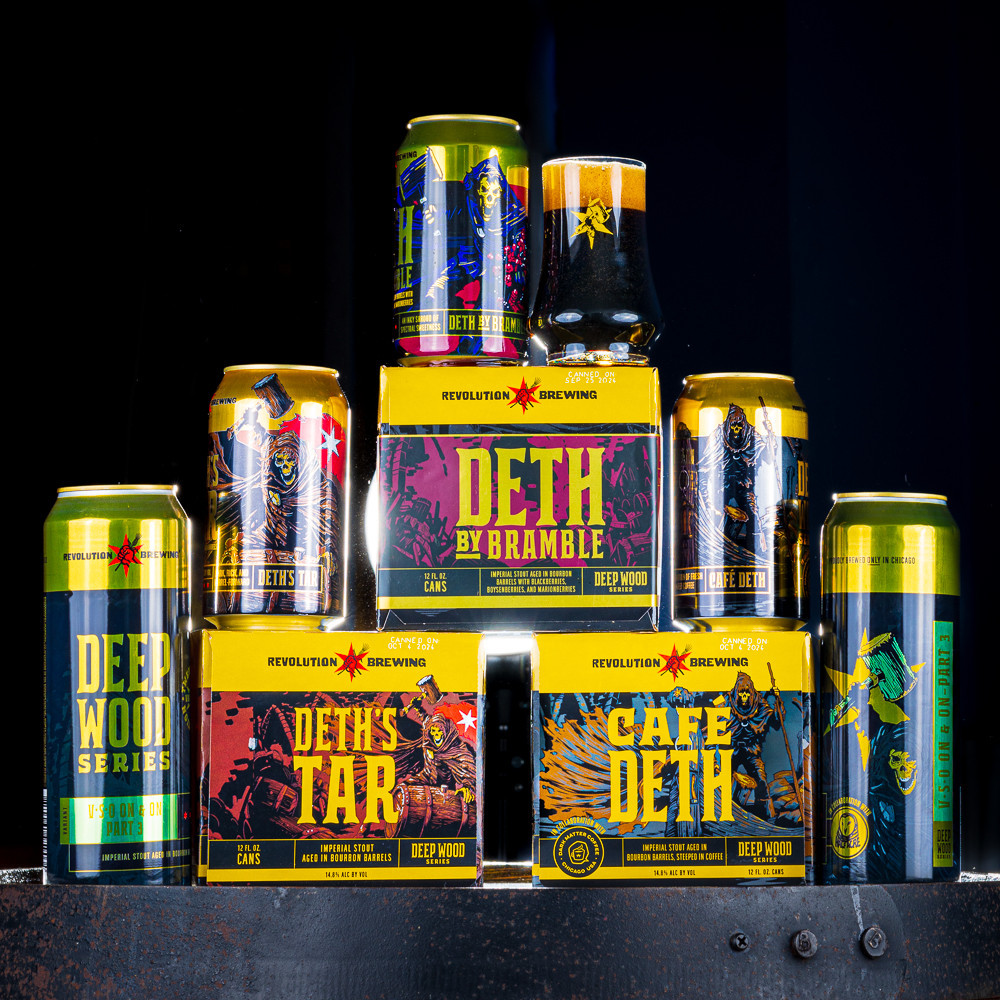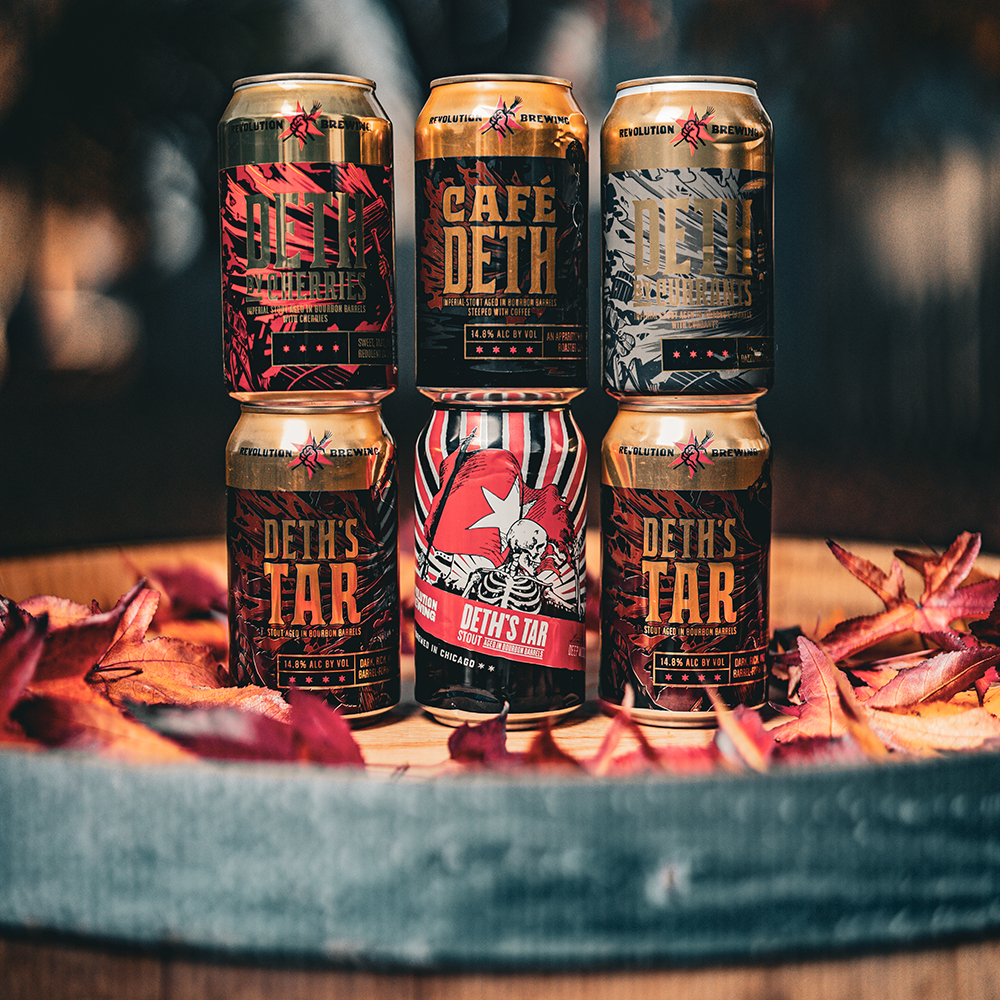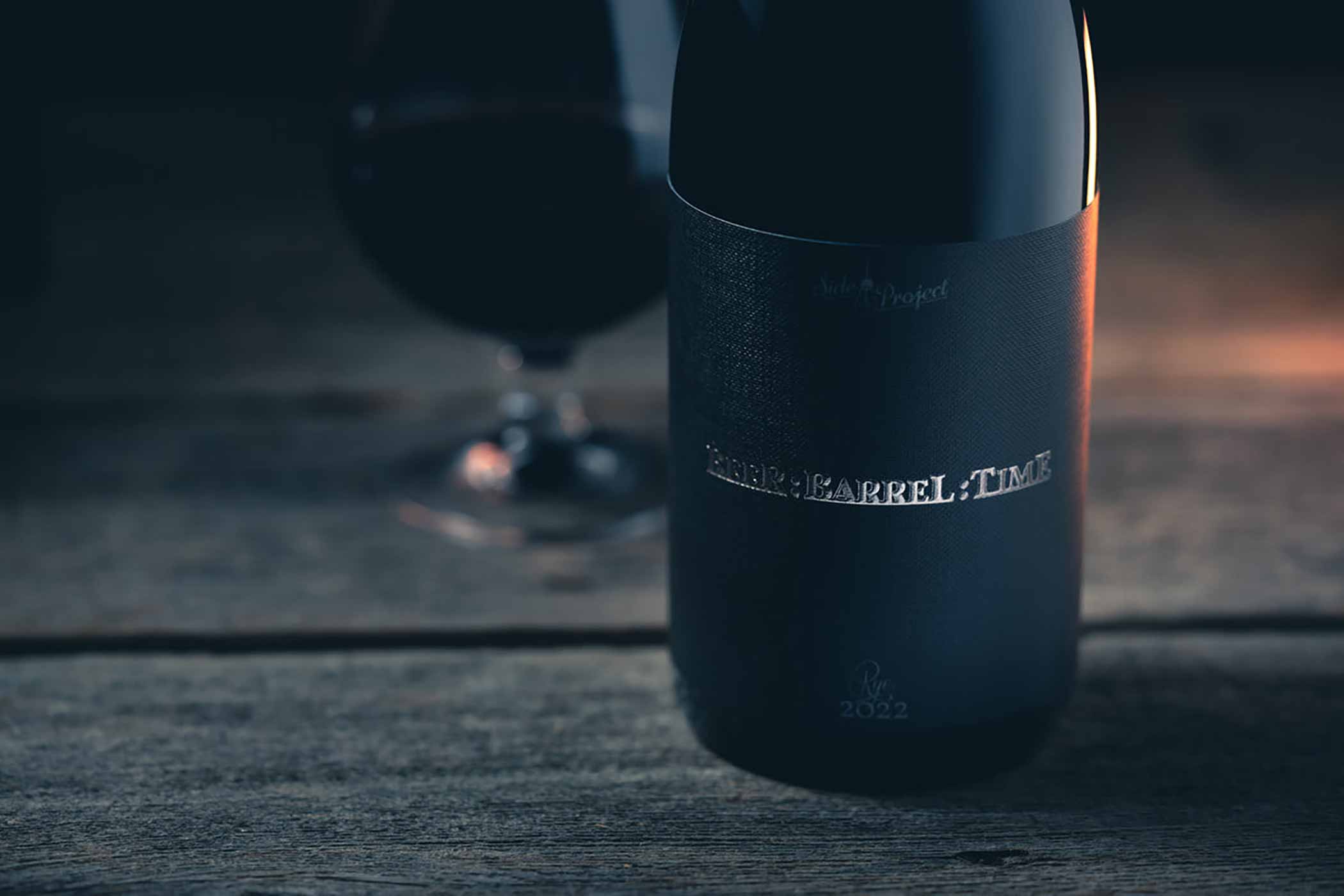Shop
The Force Has Nothing on Revolution’s Deth’s Tar
May the stout be with you!
Novembers' Top Stories:
I’m not going to pretend like I’m a big fan of Star Wars. I just barely watched the films—and that’s only because my wife, a fan of the series, wanted to introduce the classic cinema to our daughter. And despite everyone saying the movies would blow my mind, it was fine. That said, I’m a fan of the Dark Side—the Darth Vaders and Kylo Rens of the world. I have a soft spot for the villains in movies, and I feel like both are misguided individuals doing what they feel is the right thing.
Maybe I’m in the minority.
“We’re all big Star Wars fans here at the brewery,” says Revolution Head Brewer Jim Cibak. The Force was strong for the Chicago-based brewery to start brewing its iconic Deth’s Tar, paying homage to the seminal vessel of Star Wars: Episode IV, the Death Star.
Revolution Brewery Owner Josh Deth had fun with this massive imperial oatmeal stout. “Josh killed two birds with one stone: He got a cool Star Wars reference in there with the Death Star,” says Cibak, “and his last name is actually Deth, D-E-T-H!”
Cibak says that they also liked how the “tar” harkened to the beer’s jet-black appearance.
“It almost has the appearance of tar in a glass,” Cibak says. “You can barely shine a laser through it.”
Or, dare we say…a lightsaber.
So why do we love Deth’s Tar? What makes this big, bold stout so iconic? And why exactly did this seminal stout blow up (you know, not like the Death Star blew up)?
The First Time Deth’s Tar Took Flight
A long time ago, in a galaxy far, far away…called Chicago, Revolution opened its doors. In 2010, when Deth (actually pronounced similarly to teeth) started the brewery, he always planned to have a barrel-aged beer program, specifically targeting imperial stouts.
“We brewed two right off the bat,” Revolution Head Brewer Jim Cibak says. One was a collaboration with 3 Floyds Brewing (where Cibak previously worked) called Sodom, and the second was Barrel-Aged Baracus.
“Our barrel program was in its infancy back then,” notes Cibak.
Barrel Program Manager Marty Scott describes how Revolution’s first few barrel-aged projects with barleywine and porters didn’t age well. When they switched to stouts, the program began to gain traction.
In 2013, shortly after Revolution opened its production facility on North Kedzie Avenue, they brewed Deth’s Tar. The 14.8% ABV barrel-aged imperial oatmeal stout has become the cornerstone of Revolution’s barrel-aged program.
But the beer didn’t blow up right away.
“At the time, customers probably saw Deth’s Tar as our answer to Goose Island’s Bourbon County,” Scott says. “Barrel-aged stouts had some pull, but [Deth’s Tar] wasn’t lighting the world up.”
Deth remembers the first release as “definitely mellower,” with momentum building over a few years.
At first, Revolution packaged the beer in 22oz bomber bottles. Deth says people did line up to buy the bigger bottles, but switching to 12oz and eventually 19.2oz cans really rocketed Deth’s Tar to fame.
When Deth thinks of the barrel-aged program at Revolution, he feels Deth’s Tar is the…star (sorry, not sorry 🤷♀️).
“We had made other stouts and put them in the barrel before we brewed Deth’s Tar, but this beer was designed specifically for barrel aging,” Deth says. “The whiskey and wood magically balance all those dark and roasty notes. The creamy and fudge characteristics we highlight in our imperial oatmeal stout base are intended to all come together after aging.”
So, did the barrels make the beer? Or did the beer make the barrels?
Do, Or Do Not. There Is No Try
We’re not sure that Yoda has ever brewed beer before!
To brew Deth’s Tar, Cibak starts with a robust grist. Revolution uses quality pale ale malt as its base grain and quality specialty grains—roasted barley, black malt, dark crystal two, flaked oats, and oat malts—from U.K.-based malting company Thomas Fawcett and Sons. Cibak says that they’ve been happy with this solid base since the beginning, and it has not changed over the years.
“That helps give it a really nice velvety texture and super nice drinkability,” Cibak says. “Even as the ABV gets a little elevated with some barrel-aging.”
Cibak says they found that a three-hour boil gives them a nice concentration of malt sweetness. While some big stouts brewed by others adopt a marathon brewing process of twenty-four hours or more, Revolution says they can’t have the kettle occupied for that long.
“We get plenty of color pickup, reduction, and concentration of our wort in that time period,” Cibak says.
The original target gravity for Deth’s Tar is around thirty-two Plato, with a finishing gravity somewhere in the eleven or twelve Plato range. It ferments down in the tank to anywhere between 11.5% ABV and 12.5% ABV before going into the barrel.
“Nothing super complex with fermentation. We just use our house ale yeast, which is English Ale 1968,” Cibak says. “That leaves a nice malty backbone and drops down nicely after fermentation.”
As a part of the cellar process, Revolution uses a centrifuge to remove all the proteins, leaving a jet-black beer.
“You’ll be hard-pressed to shine a light[saber] through it,” Cibak says.
From there, Cibak transfers the beer into barrels, where it ages for at least a year for the largest portion of the blend, picking up between 1.5% ABV to 2% ABV.
Cibak says that in the early days of Deth’s Tar, they would brew one batch, put it into one type of barrel, and age it for a year. They weren’t huge fans of that process.
“That’s like putting all your eggs in one basket,” Cibak says. “If you get barrels that aren’t super expressive or [don’t] have a lot of character, you’re kind of left with that one batch of beer.”
Cibak credits Scott and his right-hand man, Victor Maravilla, for elevating the brand through their meticulous blending and aging.
“We call aging beer in one barrel ‘Good beer in, good beer out,’” Scott says. “That’s not necessarily a recipe for a great beer.”
Instead, Scott says they started blending multiple vintages across several varieties of Deth’s Tar.
“Incorporating second-year aged—or very old—Deth’s Tar naturally built the complexity,” Scott says.
It’s almost as if, at Revolution, barrels became as important as a lightsaber to Luke Skywalker.
Lightsaber : Jedi :: Barrel : Revolution.
When the barrel team takes over, the barrel battle begins.
Scott explains how they receive fully fermented sweeter, maltier beer (a sweet beer component) and beer that leans drier (the dry beer component) and throw them in different types of barrels at the beginning of the aging process.
The sweeter, rich, maltier beer goes in “young, unsexy barrels” because the barrels have more wood flavor, which incorporates well into the malty character. The drier beer with less of that malty character goes in older barrels with strong whiskey value trapped into the wood. That whiskey imbues into the younger, drier beer components.
“Older barrels will [lend something] sweet and fruity. Younger barrels bring fresh beer breadiness,” Scott says. “It’s the jam and the biscuit.”
As for which brand of barrels, it’s more about getting what you can.
“In short, fresh is king,” says Scott, noting that freshly emptied barrels are critical too. “If the barrels have been sitting around for a while, all the whiskey has evaporated, and then it’s just more of a good story.”
The sweet component ages anywhere from ten to forty-eight months in the unsexy barrels, while the drier component of the beer ages somewhere between six and twelve months.
After the aging process, depending on how much of a run is packaged, Scott and Maravilla taste each barrel and pinpoint which sweet and dry components make for the best blend. They base the blend on a mathematical equation Revolution created, a blend-by-numbers metric, to get the ideal finished product.
“We’ve created a few [equations] of our own,” Scott says. “But the final blend is always fine-tuned by sensory data.”
He adds, “It could be 120 sweet and 80 dry in a tank. A smaller blend could be 18 sweet and 10 dry. But once Victor and I have tasted [and approved] all the barrels in the blend, it’s cleared to go [for packaging].”
All combine into one big, beautiful, chewy oatmeal stout.
Chewie, We’re Home
Overall, Deth’s Tar is super aromatic, drinks nice and clean, and is smooth and balanced between the high alcohol, bitterness, and roast character.“One of the cool things about this beer is that, as much of the roasted barley and black malt is in there … as it ages, it doesn’t present itself as super roasty,” Cibak says. “To me, it develops a smooth, round baker’s chocolate character.”
Cibak, who recommends drinking Deth’s Tar right when it’s released, says, “When you combine that with all the nuances of the bourbon character … it works beautifully in a big stout.”
Some of the notes you’ll discover with each sip include baker’s chocolate, vanilla, and caramel.
“We don’t want it to just taste like a cup of coffee by any means,” Cibak says. “We find that with the barrel aging, it gives a really nice chocolatey note to it, sometimes almost like a Tootsie Roll.”
‘Revolutions’ Are Built on [A New] Hope
Peek at the Untappd page of Deth’s Tar, and you’ll find an imperial oatmeal stout with a super high 4.23 average (out of five) from more than 46,000 ratings.
“The beer got richer over time as we found the sweet spot that we wanted to showcase,” says Deth.
The refined approach—both in the brewing and in the barrel selection and aging processes—has led to the beer becoming the highly rated one that it is today.
Intentionally blending two- and three-year components of Deth’s Tar “led to deeper flavors, more complexity … and a more well-rounded beer,” adds Scott. “And it showed what we were capable of.”
It’s just one of the reasons that Deth’s Tar remains one of the most iconic American stouts. It’s something that we go back to again and again and again. Much like the Star Wars anthology itself. (Well, not me personally!)
“I almost feel that every year we package it,” says Cibak, “I enjoy it more each time.”

